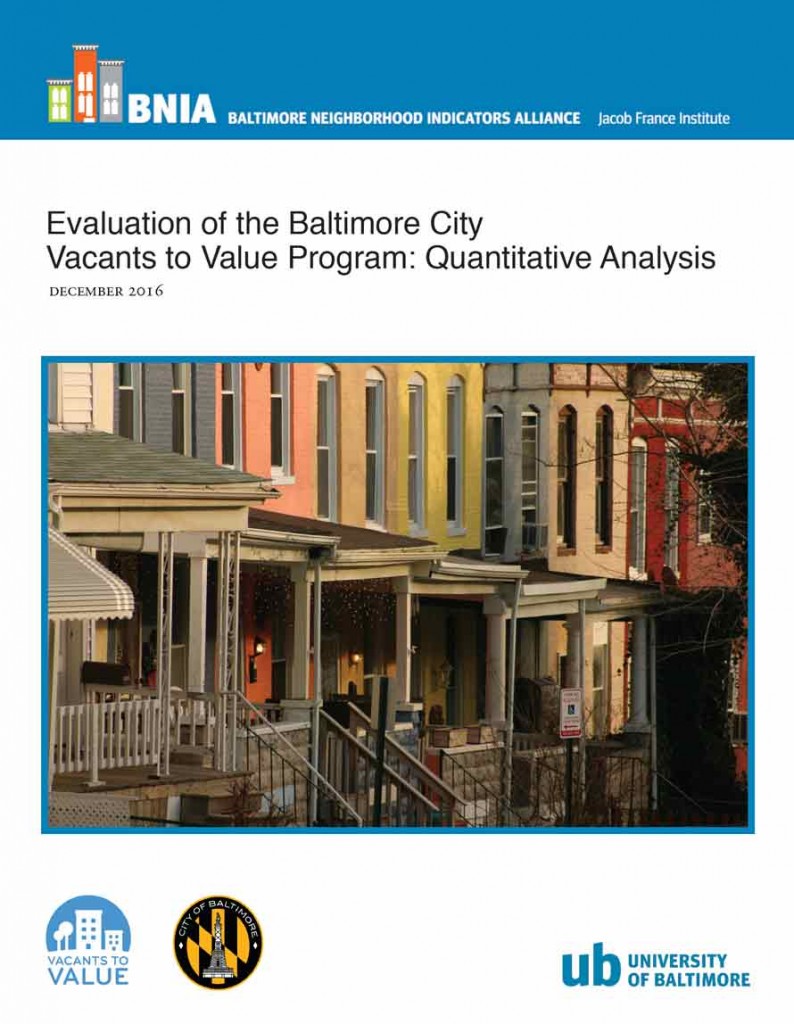 In 2010, the City of Baltimore kicked off the Vacants to Value (V2V) program, a multifaceted strategy to use code enforcement and related tools to reduce the number of vacant properties in the city and put them back into productive use. In 2015, after the program had been underway for five years, the City of Baltimore commissioned the Center for Community Progress, in partnership with the Baltimore Neighborhood Indicators Alliance-Jacob France Institute (BNIA-JFI) and the Schaefer Center of the University of Baltimore, to conduct an evaluation of the City’s Vacants to Value (V2V) program, and make recommendations for future program directions.
In 2010, the City of Baltimore kicked off the Vacants to Value (V2V) program, a multifaceted strategy to use code enforcement and related tools to reduce the number of vacant properties in the city and put them back into productive use. In 2015, after the program had been underway for five years, the City of Baltimore commissioned the Center for Community Progress, in partnership with the Baltimore Neighborhood Indicators Alliance-Jacob France Institute (BNIA-JFI) and the Schaefer Center of the University of Baltimore, to conduct an evaluation of the City’s Vacants to Value (V2V) program, and make recommendations for future program directions.
- Vacancy in Baltimore is not only an issue in the V2V treatment areas but also in several other non-V2V neighborhoods as well. While the total number of vacancies in Baltimore year-over-year has actually been increasing since 2011, the number of city-owned properties has been decreasing. Given the smaller number of city-owned properties, the need for and the number of activities that do not require city-ownership (i.e. receiverships and $900 citations) have increased within V2V treatment steadily over time.
- The V2V approach does appear to have changed market dynamics with respect to vacant house notices, median sales prices, and rehabilitation rates for the treatment areas across 2 time periods (2005-2009 and 2010-2014) compared with citywide averages.
- By V2V cohort: The 2010 cohort of V2V treatment areas has seen greater reductions in vacant house notices and increases/faster recovery in median sales prices than latter cohorts.
- By V2V cluster: In treatment areas with pre-conditions of high development activity, the V2V approach aligns and supports the reduction of vacancy and increases in sales prices. Conversely, in areas with pre-conditions of less development activity and less density, the level of V2V activity may not be enough of a market signal to affect change; vacant house notices have increased in these kinds of treatment areas over time.
- Overall, 2,467 residential properties were identified in the Streamlined Code Enforcement Neighborhoods (SCENs) and Community Development Clusters (CDCs) with some kind of V2V activity occurring between 2009 and 2015. While several properties, particularly in 2014 and 2015 have no other activity beyond the issuance of a Vacant House Notice (VHN), the most common outcome has been the issuance of a use/occupancy permit (883 or 35.8%). The next most likely outcome involves the $900 citation and/or receivership filing (679 or 27.5%). The least common final outcome has been demolition (89 or 3.6%). Time is clearly a factor for properties to come out of the VHN only or citation/receivership status. A higher percentage of properties in the 2010 cohort have a use/occupancy permit (45.6%) or demolition (5.5%) by 2015. Later cohorts still have the majority of properties in the VHN only or citation/receivership status.
- The conversion of formerly vacant properties not only removes blight from a neighborhood, but can also impact the value of properties which benefits the overall taxable revenues for Baltimore City. Between 2009 and 2014, the assessed value of vacant properties that remained vacant declined by -12.2%. Previously vacant properties with only citation/receivership activity declined by -14.4% and demolished properties decreased by -34.8%. Once-vacant properties that obtained a use/occupancy permit declined the least (by only -1.7% over the 6-year period) and were the only group of properties to experience steady increases in mean assessed values between 2011 and 2014.
 In 2010, the City of Baltimore kicked off the Vacants to Value (V2V) program, a multifaceted strategy to use code enforcement and related tools to reduce the number of vacant properties in the city and put them back into productive use. In 2015, after the program had been underway for five years, the City of Baltimore commissioned the Center for Community Progress, in partnership with the Baltimore Neighborhood Indicators Alliance-Jacob France Institute (BNIA-JFI) and the Schaefer Center of the University of Baltimore, to conduct an evaluation of the City’s Vacants to Value (V2V) program, and make recommendations for future program directions.
In 2010, the City of Baltimore kicked off the Vacants to Value (V2V) program, a multifaceted strategy to use code enforcement and related tools to reduce the number of vacant properties in the city and put them back into productive use. In 2015, after the program had been underway for five years, the City of Baltimore commissioned the Center for Community Progress, in partnership with the Baltimore Neighborhood Indicators Alliance-Jacob France Institute (BNIA-JFI) and the Schaefer Center of the University of Baltimore, to conduct an evaluation of the City’s Vacants to Value (V2V) program, and make recommendations for future program directions.